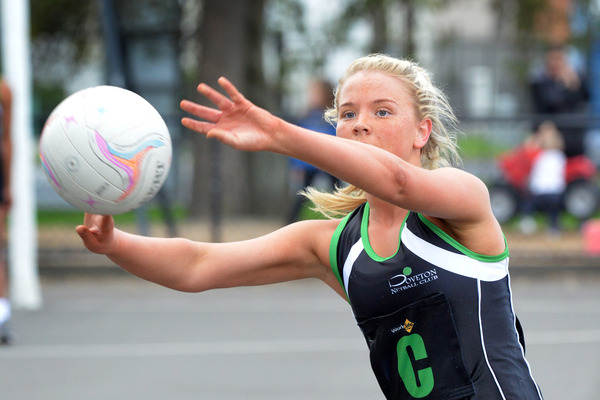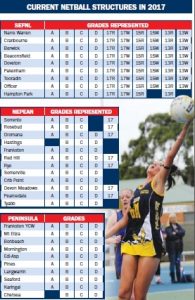
By David Nagel
It’s the biggest question that an anxious netball fraternity has needed answering in many a long day.
What happens if AFL South East Region General Manager John Anderson and his team conclude their Competition Review into the 2018 season next week and decide to bring the Nepean, Peninsula and South East Football Netball Leagues together for divisional football next year?
Just what are the options for the netballers?
First we need to take a look at the cold hard facts, starting with the structural differences in netball between the three leagues.
The table below shows that SEFNL is far further advanced than Nepean and Peninsula when it comes to the round-ball game. The expectation from SEFNL is that all nine clubs field 10 teams every weekend, from the elite A Grade level, all the way down to the 13s.
One team each in A, B, C and D grade and two teams in the 17, 15 and 13 and under divisions.
These netball teams play side-by-side with their footballing counterparts each and every weekend, at the same venue with both sports visible from certain vantage points.
It’s a scenario that creates a brother-sister sort of relationship.
The set-up is much different in the Nepean and Peninsula leagues with the union between football and netball only starting in 2013.
Both leagues began with just three senior divisions, A, B and C, and have grown slowly over the years.
Nepean introduced a 17-and-under division in 2014 and has added a D Grade to its fixturing this season. Peninsula added a D Grade in 2015 but currently have no junior representation at their venues each Saturday.
Speaking of venues –the situation is not ideal, in the Peninsula league in particular.
Of the 10 Peninsula league clubs only two, Karingal and Frankston YCW, play their netball at the same venue as the football each Saturday. Primary schools, secondary colleges, indoor centres, even the Springvale and District Netball Association headquarters in Dingley are used for home and away matches.
It’s a better story in Nepean with 10 of the 12 clubs sharing facilities with the footballers.
So what are the options for next year?
1. For all clubs –in all 10 grades- to have the same fixturing as the football clubs in a new divisional structure and play at the same venues.
2. For all clubs –in four senior and just three junior grades- to have the same fixturing as the football.
3. For all clubs –seniors only- to have the same fixturing as the football. Junior competitions to be run separately at different venues.
4. All competitions to be played at stand-alone venues (Such as Casey, Frankston or Dingley).
5. For all three netball leagues to keep their current integrity and, through clever fixturing, maintain a close bond with their football counterparts despite being in different divisions.
Option one is almost impossible to comprehend.
Firstly, the dearth of netball facilities at football grounds in the Peninsula league wouldn’t allow it.
Secondly, the structural differences between SEFNL and its contemporaries are too great to narrow in such a short space of time.
It would be ridiculous to expect the current-day Nepean and Peninsula league clubs to suddenly click their fingers and come up with two sets of juniors for each grade. What a massive burden that would be on volunteers who are already stretched to the limit.
The players are there for the Nepean and Peninsula league clubs to grow, reaching from Sorrento in the South to Edi-Asp in the north. Stand-alone district associations, similar to the Casey Netball Association that has many of its members involved in SEFNL, are run in Chelsea, Frankston, Mornington and as far south as Tootgarook.
“The players are there –the associations and clubs just need to work closer together, there is no excuse for the clubs not to attract juniors,” according to a source.
Option two would be easier for Nepean and Peninsula to manage, needing to find just one team for each age group instead of two, but would be a massive step backwards for SEFNL clubs, who would need to drop a team from each age group.
The SEFNL clubs have worked hard to get two teams competing in each junior grade, growing from just one in 2013, so losing a team from each age group would be a bitter pill to swallow.
Option three would be just as devastating.
For the SEFNL clubs to lose the Saturday –same-venue- connection with their juniors would cut to the core.
Keeping the seniors and juniors together in netball is crucial, with so many senior players doubling up as junior coaches, it happens at every club. Splitting the juniors and seniors would either see those coaches disappear or have to give up their own playing ambitions.
Finding timeslots to play at these already busy venues would also be an issue.
Option four would see all three leagues take on the Southern Football Netball League formula of playing all grades of netball at a neutral venue –totally separate from the football.
Keysborough was the last SEFNL club to join Southern, a league that plays the majority of its Saturday matches at the Springvale and District Netball Association courts in Dingley.
The Gazette spoke with a member of Keysborough recently, who said it was great that both sports train together during the week, but playing at different venues had certainly diminished the camaraderie and spirit between the two groups.
Playing alongside the footballers is something they really do miss to this very day…there is no longer that sense of belonging!
And option five – well it seems to make the most sense!
This is what round one of football might look like in a new divisional set up in 2018.

The above consists of 12 teams from Nepean, 10 from Peninsula and nine from SEFNL, split into three divisions.
To keep the current netball structures in place, the fixturing of the 15 football matches each week would need to include the following.
Six of the former Nepean, five of the former Peninsula, and at least four of the SEFNL clubs would need to be fixtured for home games each week. That way each league could run its own integral competition and maintain the same amount of teams as this year.
AFL South East has access to fixturing equipment worth millions of dollars, with club and league requirements entered and a suitable draw spat out as a result. Surely it could cope with these basic requests made above.
For the SEFNL netball clubs, the corresponding round one would look something like this.

Yes, the visiting teams change for both sports, but at least the home club gets to experience the brother-sister relationship that has been so enduring over the years. And clubs like Beaconsfield, Berwick, Cranbourne and Narre Warren would get to experience a full-blown local rivalry –complete with football and netball- at least six times throughout the year.
Yes, it’s not perfect, but with the use of a million dollar computer system we might be able to keep everyone a little bit happier than we first thought in regards to a very complex issue!













